We Still Get Surprised
Whenever you move to a new place, you notice things that are different from where you lived before. It takes awhile for your new surroundings to become your new normal. We’re sure there’s some kind of psychological principle that explains it, but since its August – the “silly season” – we’re not going out of our way to find it. We’ll just trust that you’ve had the same experience.
When we arrived in Portugal last year, LOTS of things were different. Sure… people wore pants, and they drove on the same side of the road. But they spoke a different language, and there were cobblestones, and there were extra toilet-like things in the bathroom, and on and on. Then, over the first few months, we got used to it. Mostly.
There were still things that made us do a double-take. Things that made us stop in our tracks for a second look.
These were the things that made us say “Huh?!”.
And now, over a year later, we’re still finding those things. Here are some that we’ve noticed lately.
A quick heads up before we get started. There are some images below that some folks might find disturbing. We’ll warn you before we get to them.
#1 – Keys
The key to our apartment is different from any we had back in the US. It’s three dimensional. There are ridges and grooves that are identical on both sides. That’s great when you’re fumbling to get it into the lock, with a bag of groceries in the other hand or a dog on a leash. The key works either way.
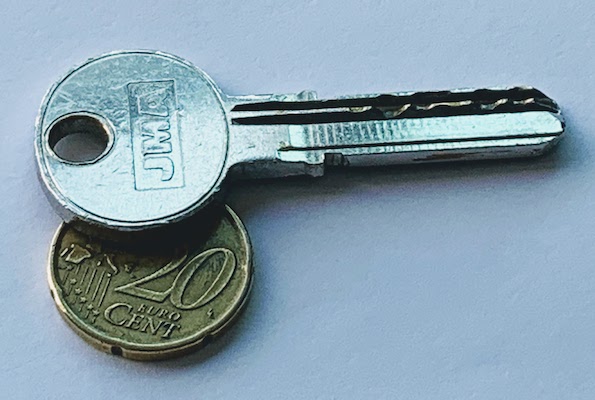
But the biggest surprise is the cost. Mike went to a local shop that cuts chaves (keys) to get two more made. They were € 12 each! Huh?!
#2 – Electric Plugs
We came to Portugal with a sack full of power adapters so we could continue to plug in our computers and charge our phones. The plugs here are different. Just two round pins. No ground wire. Like the keys, the plugs can go in either way.
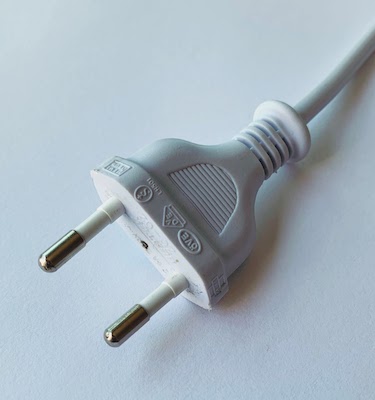
According to Ted Kury, a guy who studies electricity for a living, round pins were an innovation. “People thought they made the plug fit more securely in the socket.”
And there’s more “juice” at the plug. The US was electrified first and adopted 110 volts as a standard. When the Europeans got around to it, they went a different route. Mr. Kury again:
Companies in Europe realized that supplying power at 220 volts instead of 110 volts would be cheaper. At a higher voltage, electric companies can deliver the same power with less current – picture a narrow stream flowing quickly compared to a wider stream flowing slowly. And less current allows for thinner wires. Since the copper that’s used for electric wires is expensive, higher voltage could save money.
#3 – Dogs With Tails
Before we got our Boston Terriers, we had three different cocker spaniels. Each of them had their tails “docked” shortly after birth. (That’s a nice way of saying “cut off”. And a really rotten way to say “Welcome to the world, puppy!”)
One day at the park Mary noticed something that made her go “huh?!” She saw a schnauzer walking across the cobblestones with a long wagging tail.
She thought it was so strange until a few days later she saw a cocker spaniel with a long wagging tail. And then she saw a poodle, and knew something was weird.
Turns out it’s not weird at all. The European Convention for the Protection of Pet Animals, passed by the European Parliament in 1987, prohibits the docking of dogs’ tails for non-medical reasons. Later resolutions outlawed ear clipping.

Image credit: Alexas_Fotos on pixabay.com
These conventions have been adopted by almost all EU countries, except France, Hungary, and…Portugal! In Portugal, tail docking is allowed, if it is performed by a veterinarian.
Our visibility is limited to our neighborhood, but we think banning the practice of cutting off puppies tails is a great kindness to “man’s best friend”.
#4 – Cigarette Packs
OK. This section contains the images we warned you about earlier. Scroll to the next headline if you’re squeamish.
We have more than a passing acquaintance with cigarettes, having both been smokers into our late 20’s. Kicking the habit was one of the hardest things we ever did, and we didn’t have the benefit of the gums and patches available today.
In the US, cigarette packs have had the Surgeon General’s warning for years. Perhaps it has gotten bigger over the years, but it’s still just some words.
Here in Portugal, they go further. Every pack has a warning message, in big, bold print. But then, they add the graphics. Not just photos. GRAPHIC photos of what smoking can do to you.
Mary has been collecting discarded packs for several months. Here are some examples.
Last chance to look away.
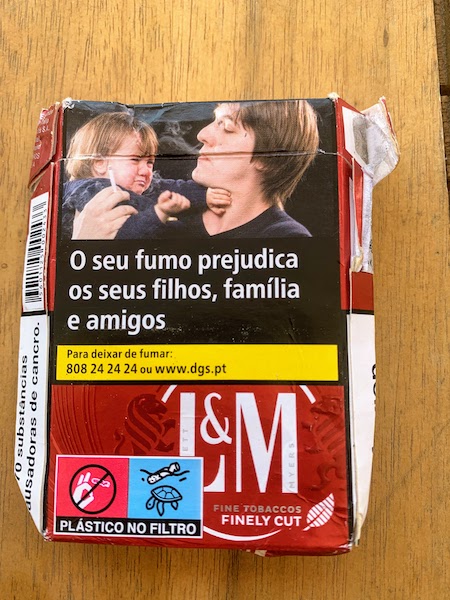
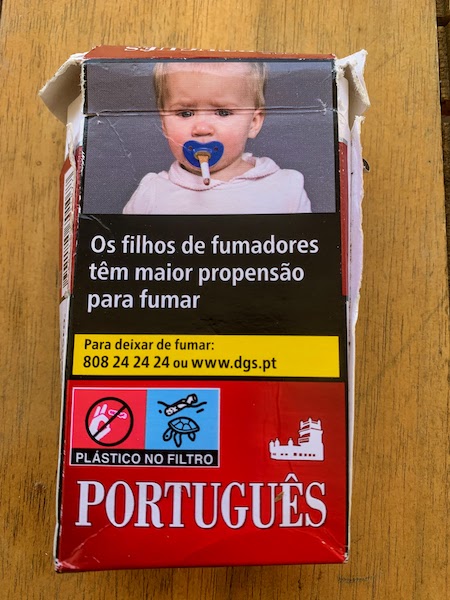
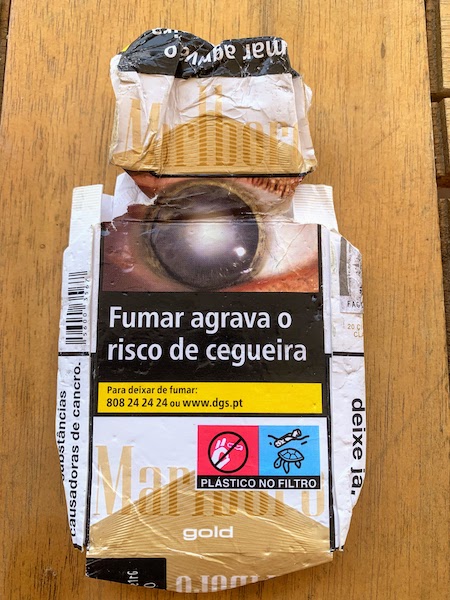
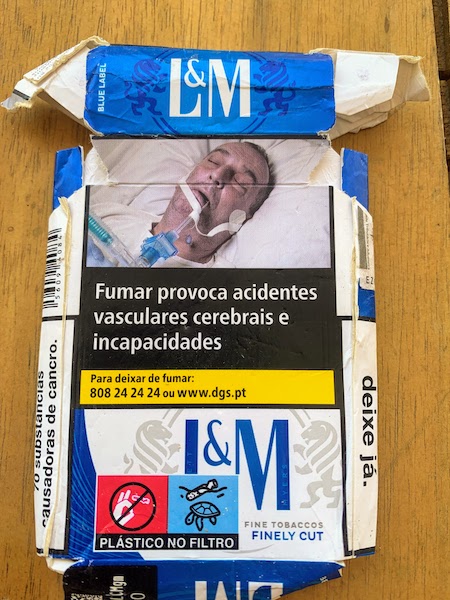

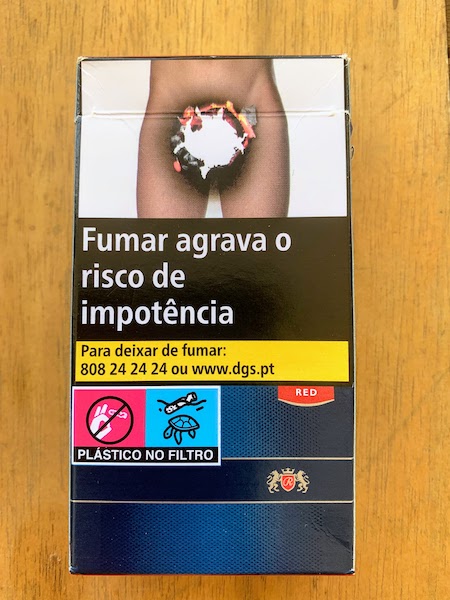
Images like these have not made it to the US…yet. The U.S. Food and Drug Administration has adopted new rules for warnings on cigarettes sold in the United States that include large, graphic images. (Not quite as shocking as some of the ones above, but close.) The implementation of these rules has been delayed until 2023 by a court order in a lawsuit filed by a tobacco company. (You can see the proposed rules and images here.)
#5 – Vending Machines
It’s no surprise to say that Europeans have a much different attitude about sex and sexuality than people in the US. One visible aspect of that is the vending machines that are found outside many farmacias. We first saw one in Porto. It just sold condoms.
The one in our neighborhood has a broader selection of merchandise.

In addition to condoms, it sells lubricants, vibrators, and other sex toys. But it doesn’t stop there. Also on offer are diapers and baby formula, because you might need those if you didn’t get the condoms earlier…
The only problem we see is that the local machine has been broken for months.
#6 – In the Grocery Store Flyers
But not to worry! The local supermercado has you covered. It’s right there, with the toothbrushes.

You might need the toothbrush after using the “Morango” (strawberry) lube. These people think of everything.
#7 – Roupa Usada Bins
Across the street from our apartment, next to the recycling bins, is a large metal container with the words “Roupa Usada” – “used clothes” – in large letters. This is one of several we’ve seen around the neighborhood.

We’ve written before about the processes in Portugal for the collection and recycling of household waste. These used clothing bins are a logical extension of a recycling / reuse culture. But unlike waste collection, which is managed by local governments, the roupas usadas bins are owned by private companies or charitable organizations. The one across the street is owned by Andry & Philippe Filtex.
We did a little digging and were surprised to learn that used clothing is a big business around the world. One estimate says it’s currently a $ 36 Billion industry and is expected to grow to $77B by 2025 [4]. Much of the activity is done in places like Africa or Malaysia, where 100Kg bales of used clothes can be purchased for $0.59 to $2.59 per Kg.
It’s not immediately clear how our neighborhood bin fits in the global economy, but the sign on the front shows how they process what they collect. They say that 90% of the textiles they collect have a second life.
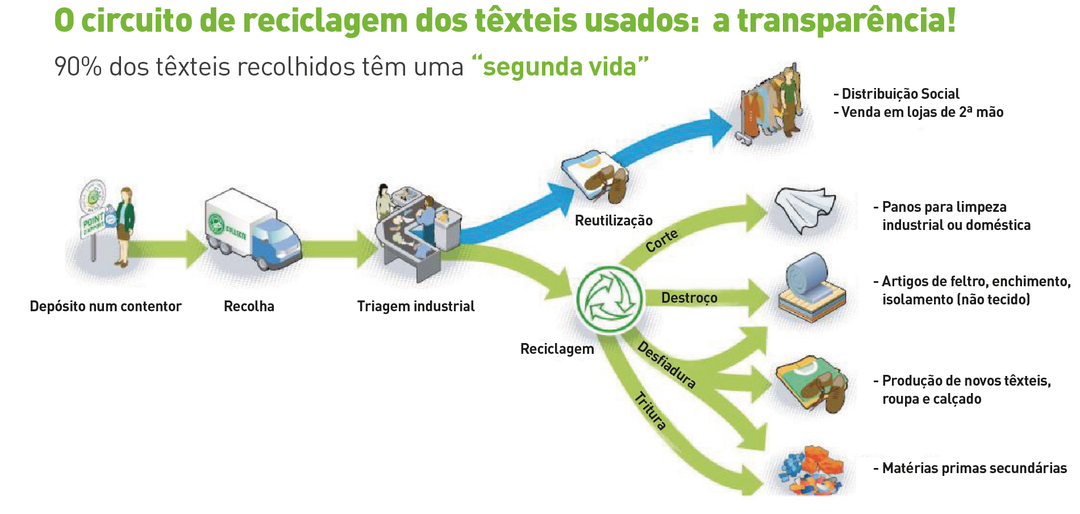
The items collected are sorted and evaluated. Some are identified for reuse and are sent to second-hand stores or for “social distribution”.
What can’t be reused is cut up to make cleaning cloths; used in the production of new textiles, clothing, and footwear; or converted into raw material for other processes. A small percentage, including items made of felt, filling, or insulation, are destroyed.
#8 – Hillbilly Engineering Comes to Portugal
This is something that maybe made our neighbors say “Huh?!”
Back in the US, when we needed to move something heavy, we put it in the back of a car or our pickup truck. Over here, it’s a different story.
We have to buy special dog food for Sox. It’s expensive, so we try to buy it in bulk to get a better discount. A 12 Kg (26.5 lbs) bag lasts about five months. The first time we bought it, Mike slung the bag over his shoulder and hiked about 500 meters up the hill to our apartment. When it came time to buy a replacement this week, he decided to do like his grandmother always told him and “work smarter, not harder”.
He took the canvas bag off our grocery cart and used the bare frame as a two wheel dolly. With a couple of bungee cords (who moves to Portugal with bungee cords?) to secure the bag, he had a much easier time getting the food home.
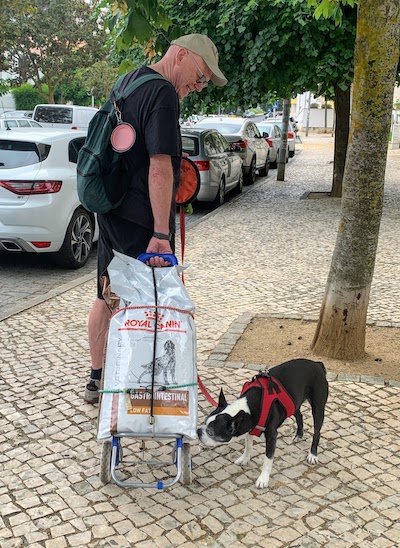
Sox was very interested in this activity, though she didn’t offer to help pull the dolly!
That’s All Folks!
We’ll stop here for today, but we’ve already got a list started for the next installment of “Things That Make Us Say ‘Huh?!'”.
What’s funny things have you seen in your neighborhood this weekend? Leave a note in the comments below or with the Contact Us form.
Until next week / Até a próxima semana
Mary and Mike
The Cook and The Writer
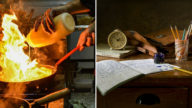


Hi Mike and Mary…The pictures you include in your blogs are always interesting, and many weeks ago it occurred to me that I have NEVER seen trash in the street gutters, on the walkways, in the entryway to shops, on the manicured grassy areas or ANYWHERE!! Is clean-up done every morning by city staff people OR Is there never a need for clean-up??
Oh, what a fun and interesting post! I feel like I’m on vacation. Thanks, Mary & Mike, for the adventure.
The first time I saw cigarette packs like those I was in Canada. Blacken lungs, dissected hearts, tracheotomies…I was shocked and it took me a minute to realize they were in fact cigarette packs. Other than the one on impotence these seem tame by comparison.
I look so forward to every update. We have lived in Lagos for 1 full year now- no regrets.